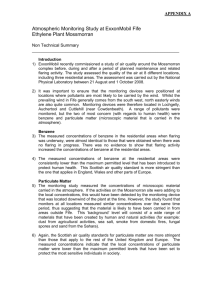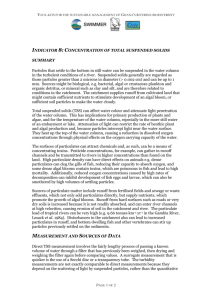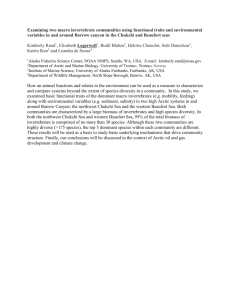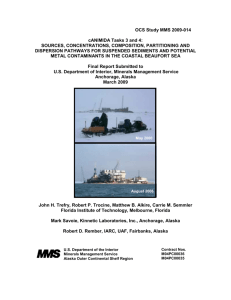Microsoft file
advertisement
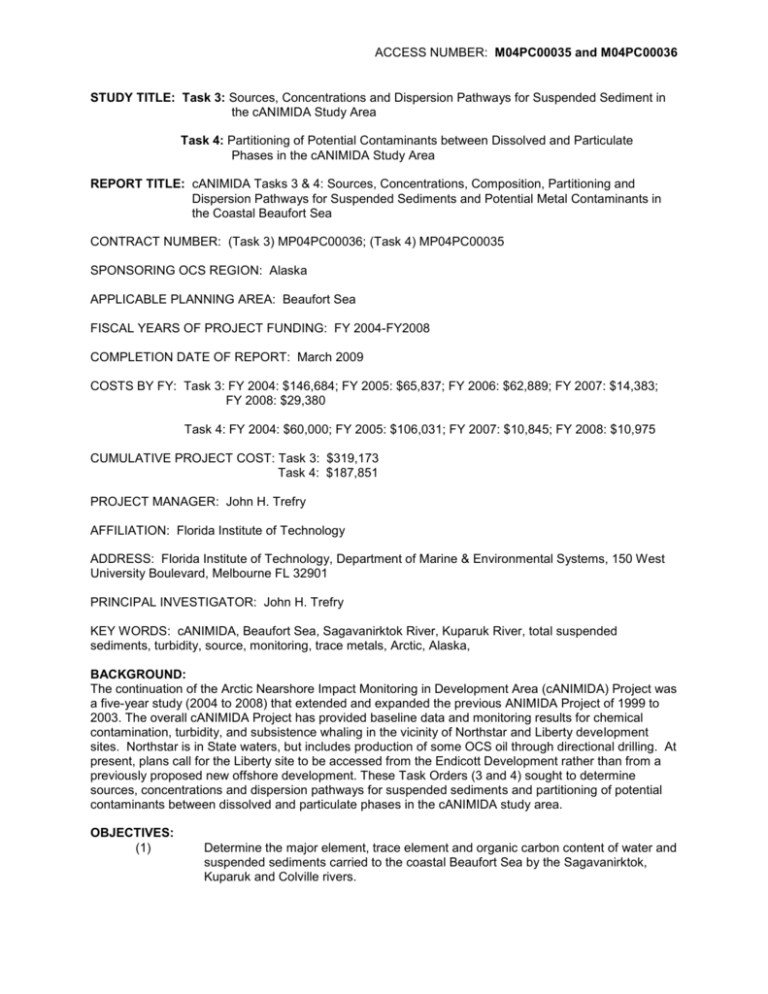
ACCESS NUMBER: M04PC00035 and M04PC00036 STUDY TITLE: Task 3: Sources, Concentrations and Dispersion Pathways for Suspended Sediment in the cANIMIDA Study Area Task 4: Partitioning of Potential Contaminants between Dissolved and Particulate Phases in the cANIMIDA Study Area REPORT TITLE: cANIMIDA Tasks 3 & 4: Sources, Concentrations, Composition, Partitioning and Dispersion Pathways for Suspended Sediments and Potential Metal Contaminants in the Coastal Beaufort Sea CONTRACT NUMBER: (Task 3) MP04PC00036; (Task 4) MP04PC00035 SPONSORING OCS REGION: Alaska APPLICABLE PLANNING AREA: Beaufort Sea FISCAL YEARS OF PROJECT FUNDING: FY 2004-FY2008 COMPLETION DATE OF REPORT: March 2009 COSTS BY FY: Task 3: FY 2004: $146,684; FY 2005: $65,837; FY 2006: $62,889; FY 2007: $14,383; FY 2008: $29,380 Task 4: FY 2004: $60,000; FY 2005: $106,031; FY 2007: $10,845; FY 2008: $10,975 CUMULATIVE PROJECT COST: Task 3: $319,173 Task 4: $187,851 PROJECT MANAGER: John H. Trefry AFFILIATION: Florida Institute of Technology ADDRESS: Florida Institute of Technology, Department of Marine & Environmental Systems, 150 West University Boulevard, Melbourne FL 32901 PRINCIPAL INVESTIGATOR: John H. Trefry KEY WORDS: cANIMIDA, Beaufort Sea, Sagavanirktok River, Kuparuk River, total suspended sediments, turbidity, source, monitoring, trace metals, Arctic, Alaska, BACKGROUND: The continuation of the Arctic Nearshore Impact Monitoring in Development Area (cANIMIDA) Project was a five-year study (2004 to 2008) that extended and expanded the previous ANIMIDA Project of 1999 to 2003. The overall cANIMIDA Project has provided baseline data and monitoring results for chemical contamination, turbidity, and subsistence whaling in the vicinity of Northstar and Liberty development sites. Northstar is in State waters, but includes production of some OCS oil through directional drilling. At present, plans call for the Liberty site to be accessed from the Endicott Development rather than from a previously proposed new offshore development. These Task Orders (3 and 4) sought to determine sources, concentrations and dispersion pathways for suspended sediments and partitioning of potential contaminants between dissolved and particulate phases in the cANIMIDA study area. OBJECTIVES: (1) Determine the major element, trace element and organic carbon content of water and suspended sediments carried to the coastal Beaufort Sea by the Sagavanirktok, Kuparuk and Colville rivers. ACCESS NUMBER: M04PC00035 and M04PC00036 (2) Determine concentrations of dissolved and particulate metals across the freshwaterseawater mixing zone into the Beaufort Sea. (3) Determine pathways for transport of water, chemicals and suspended sediments from rivers under ice to the coastal Beaufort Sea during the spring floods. (4) Determine concentrations of suspended sediments, dissolved metals, particulate metals and supporting parameters in the coastal Beaufort Sea, including areas near offshore oil- and gas-related activities such as Northstar. (5) Determine distribution coefficients (Kd) for metals in the Beaufort Sea and adjacent rivers. DESCRIPTION Field activities for cANIMIDA Tasks 3 and 4 included sampling rivers during spring breakup in May-June 2004 and 2006 (Figure 1a), through ice sampling of the Beaufort Sea during spring floods in May-June 2004 (Figure 1b) and 2006 and by sampling rivers and offshore waters during the open-water periods of July-August 2004, 2005 and 2006. The Sagavanirktok and Kuparuk rivers were sampled daily during late May and June in 2004 and 2006. Laboratory analyses included total suspended solids (TSS) and the following particulate metals: aluminum (Al), arsenic (As), barium (Ba), calcium (Ca), copper (Cu), iron (Fe), potassium (K), magnesium (Mg), manganese (Mn), sodium (Na), nickel (Ni), lead (Pb), zinc (Zn) and organic carbon. Concentrations of the following dissolved metals also were determined: As, Ba, Ca, Cd, Cr, Cu, Fe, K, Mg, Mn, Ni, Pb and Zn. Water and suspended sediments also were collected under the ice, seaward of the rivers during the early days of spring runoff in 2004 and 2006 when the coastal Beaufort Sea was still ice covered. Vertical profiles of conductivity, temperature and turbidity were collected at each site along with samples for TSS, particulate metals, particulate organic carbon and dissolved metals. During the open-water period in 2004, 2005 and 2006, numerous vertical casts in the water column were made throughout the coastal Beaufort Sea to measure salinity, temperature and turbidity. Turbidity also was measured by in situ turbidimeter, by laboratory turbidimeter using discrete samples and by filtration/gravimetry using discrete samples. Samples were analyzed for the same particulate and dissolved trace metals as listed above for rivers. (a) (b) Figure 1. (a) Kuparuk River overflows road at East Channel on May 28, 2006 and (b) sampling the coastal Beaufort Sea through 2-m thick ice during May 2004. SIGNIFICANT CONCLUSIONS: About 90% of the annual transport of TSS from the Sagavanirktok, Kuparuk and Colville river occurs during the spring floods. More than 85% of the data points for Ba, Cu, Cr, Ni and Pb in suspended sediments from the three rivers during 2004 and 2006 were within predicted ratios to Al for Beaufort Sea sediments. This overall continuity shows strong support for river particles as a key source for metals in ACCESS NUMBER: M04PC00035 and M04PC00036 coastal sediments as well as showing that concentrations of these metals in Beaufort Sea sediments are not significantly influenced by anthropogenic inputs or diagenetic processes. A trend of maximum concentrations of dissolved trace metals in rivers during peak flow in spring, first observed during the ANIMIDA Project, was again observed in some cases in the 2004 and 2006 data. This trend is natural and is influenced by the discharge of soil interstitial water and shallow surface water that is diluted by snow melt and flushed from surrounding soils into the rivers. In contrast concentrations of dissolved major elements such as Ca, or even Ba, varied by <10% over the May-June period in the rivers. A simple distribution coefficient (Kd) was used to describe metal partitioning between particulate and dissolved phases. For example, the Kd values calculated for Ba in the Sagavanirktok, Kuparuk and Colville rivers were statistically equal, despite differences in absolute values, suggesting that partitioning of Ba between dissolved and particulate phases is a quasi-equilibrium controlled process between free Ba2+ and suspended particles. Reasonably good agreement in Kd values among rivers and seasons also was found for Cd, Cu, Cr, Pb and other metals. The Kd relationship can be used to help explain and predict concentrations of dissolved metals in area rivers. During the spring floods, water from the Sagavanirktok River (SR) was traced beneath the ice, relatively undiluted, to a distance of ~6 to 8 km offshore and ~8 to 10 km alongshore in ~3 days. The SR plume was ~1.0 to 1.5 m thick with the majority of the river water (>60%) in the top 1 m over an area of ~315 km2. This information can be used to help predict potential spill trajectories under ice as well as transport pathways for freshwater, suspended sediments and dissolved chemicals in the coastal Beaufort Sea. No significant differences in concentrations of TSS were found due to oil and gas operations near Northstar Island relative the overall cANIMIDA study area. Concentrations of dissolved trace metals were lower than reported values for surface seawater worldwide and well below the EPA water quality criteria for chronic impacts in marine waters. No significant difference in concentrations of dissolved trace metals were observed near Northstar Island relative to the overall cANIMIDA study area during the 2004, 2005 and 2006 study period. Concentrations of particulate metals during the open-water season showed the variable importance of scavenging by iron oxides (e.g., As), uptake by biota (e.g., Cd) and possibly some anthropogenic inputs (e.g., Pb) to metal distributions. Only concentrations of particulate Cd during 2004 (plankton) and particulate Pb during 2006 (possibly anthropogenic) were higher in the Northstar area than in the overall cANIMIDA study area. With respect to potential contaminants, the overall conclusion is that concentrations of suspended sediments, as well as dissolved and particulate metals, are at background levels, with a possible minor exception for Pb in 2006. The data produced during cANIMIDA provide a strong baseline for future, longterm monitoring. STUDY RESULTS: During the 2 to 3 weeks of spring floods in May-June 2004 and 2006, about 60% of the annual water flow from the Kuparuk River and about one third of the annual water flow of the Sagavanirktok River were carried to the Beaufort Sea. Interannual variability in the onset date for river flow, volume at peak flow and the duration of peak flow can be significant as shown in Figure 2a. During May-June, maximum concentrations of total suspended solids (TSS) ranged from 60 mg/L (2006) to 106 mg/L (2006) in the Kuparuk River and 285 mg/L (2004) to 353 mg/L (2006) in the Sagavanirktok River. Differences in the chemical composition of the river particles could often be related to the mineralogy of the drainage basin as, for example, the highest Ca values were found for particles in the carbonate-richer Sagavanirktok River basin and the highest Al values were found in the more clay-rich Colville River (Figure 2b). ACCESS NUMBER: M04PC00035 and M04PC00036 (a) (b) 12 2000 Kuparuk River 1200 40K ft3/s 800 Sagavanirktok 10 8 Ca(%) Water flow (m3/sec) 1600 2001 2002 2004 2006 6 4 20K ft3/s Colville 0 0 5/15 Kuparuk 2 400 5/25 6/4 6/14 0 6/24 2 4 6 8 10 Al (%) Figure 2. (a) Hydrographs during the spring floods in 2001, 2002, 2004 and 2006 for the Kuparuk River (Data from U.S.G.S. http://waterdata.usgs.gov/ak/nwis) and (b) concentrations of calcium (Ca) versus aluminum (Al) for suspended sediments from the Sagavanirktok (circles), Kuparuk (diamonds), and Colville (triangles) rivers during 2001, 2002, 2004 and 2006. Markers show means and lines show standard deviations. The high water flow from rivers during the spring floods was carried to a Beaufort Sea that was covered with ~2-m thick, land-fast ice (Figure 3a). The fresh and relatively warm (slightly > 0C) discharge from the rivers flowed out onto and then under the land-fast ice where it mixed with the colder marine waters to form a 1 to 2 m thick under-ice lens of brackish water (Figure 3b) that extended >15 km offshore. Sampling in the Beaufort Sea was carried out via holes drilled through the ice in 2004 and 2006. Salinity, 18O and dissolved silica were used in 2004 to identify, trace and quantify the movement of SR water Salinity (b) (a) Sagavanirktok River Water Depth Under Ice (m) 0 0 5 10 15 20 25 30 35 2 Station K1 near mouth of Kuparuk River 4 6 Temperature Salinity 8 10 -2.0 -1.5 -1.0 -0.5 0.0 Temperature (°C) Figure 3. (a) Photograph showing spring flow of the Sagavanirktok River northward to the ice-covered Beaufort Sea and (b) typical vertical profiles for salinity and temperature under the ice where river water was flowing over seawater. water beneath a 2-m thick ice layer into the coastal Beaufort Sea (Figure 4a). The SR water was transported beneath the ice, relatively undiluted, to a distance of ~6 to 8 km offshore and ~8 to 10 km alongshore in ~3 days. The calculated total volume of Sagavanirktok River water under ice was ~0.5 km 3 across an area of ~300 km 2; this amount of freshwater was equal to about half the total discharge from the river during the study period. The westerly flowing, 1 to 1.5 m thick plume of Sagavanirktok River water interacted with the easterly flowing plume from the Kuparuk River to result in increased northward transport of freshwater. Transport of relatively undiluted river water beneath the ice provides an important source of freshwater to the coastal ocean that impacts seasonal landfast ice production, local circulation ACCESS NUMBER: M04PC00035 and M04PC00036 (a) -1 -1.5 -2 Depth Under Ice (m) S5 -2.5 80 70 600 5 40 30 0 2 0 1 600 5 0 4 60 -3 -3.5 40 -4 30 -4.5 20 -5 70.44 70.45 Latitude 15 20 2 4 6 10 -5.5 70.43 10 70 30 0 2 0 1 70.42 5 0 80 50 -6 0 90 30 0 2 10 Turbidity (NTU) (b) S7 Water Depth (m) S3 -0.5 70.46 70.47 0 SW4-1 May 25 SW4-2 May 28 SW4-3 May 31 SW4 August 5 8 Figure 4. (a) Cross section showing the percent of Sagavanirktok River water under ice at increasing distances from the river mouth (stations S3, S5 and S7, May 2004; two black areas at base of figure on left and right denote the seafloor) and (b) vertical profiles for turbidity under ice at station SW4 on three different days in May 2004 as well as one day in August 2004 during the open-water period. and provides a pathway for potential contaminants or spills originating from activities on the North Slope to move offshore. Concentrations of suspended sediments (shown as turbidity in Figure 4b) were greatest in the incoming freshwater and showed both temporal and spatial variations as a function of changes in river inputs and settling of particles. Concentrations of TSS, under ice, along the freshwaterseawater mixing zone into the Beaufort Sea decreased sharply and showed settling of >50% of the river-borne suspended sediments. Concentrations of TSS in the Kuparuk River during summer 2004, 2005 and 2006 averaged 1.0 mg/L, about 25 to 60 times lower than during the spring floods. Values for TSS in the Sagavanirktok River were variable during summer with a range of 0.5 to 53.4 mg/L, with the maximum value linked to a summer rain storm. All TSS values in rivers during summer were 10 to >300 times lower than during the spring melt. Values for Kd in the summer river samples were within the range of values found for spring for As, Cd, Cr and Pb in the Sagavanirktok River, but lower in summer than spring for Ba, Cu, and Zn. Concentrations of dissolved As, Cr and Pb were lower than reported values for surface seawater worldwide and well below the EPA water quality criteria for chronic impacts in marine waters. No significant differences in concentrations of dissolved trace metals were observed near Northstar Island relative to the overall cANIMIDA study area during 2004, 2005 and 2006. Concentrations of particulate metals during the open-water season showed enrichment of selected metals relative to Al due to scavenging by particles (e.g., As), uptake by biota and possibly some anthropogenic inputs (e.g., Pb in Figures 5a) as explained with more specific details in the report. Concentrations of particulate metals in the overall cANIMIDA area were not different than near Northstar Island with the exception of Cd in 2004 (plankton) and Pb in 2006 (possibly anthropogenic). A more detailed study of the biogeochemistry of As and Hg were developed during the cANIMIDA Project. Concentrations of As in phytoplankton were enriched by a factor of ~5,000 relative to seawater, indicating that bioaccumulation of dissolved As by phytoplankton was occurring (Figure 5b). No significant differences were observed in concentrations of As between phytoplankton and zooplankton, or between zooplankton and fish. Concentrations of As were significantly greater in amphipods than in zooplankton and also were significantly greater in clams than in phytoplankton. ACCESS NUMBER: M04PC00035 and M04PC00036 (b) 20 (a) Pb (µg/g, dry wt.) Northstar Liberty 30 Linear regression line and 99% prediction interval based on 1999-2002 data As (g/g, dry wt.) 40 2006 20 10 Y = 2.4X - 0.3 r = 0.87, n = 196 0 0 2 4 6 8 16 Phytoplankton Zooplankton Amphipods Clams Fish 12 8 4 0 10 Phyto Zoo Amph Clams Fish Al (%) Figure 5. (a) Concentrations of particulate lead (Pb) versus aluminum (Al) for suspended sediments from the coastal Beaufort Sea in summer 2006. Solid line, equation and prediction interval (dashed line) are from linear regression for bottom sediments collected from 1999-2003 (Trefry et al., 2003) and (b) average concentrations of As in phytoplankton, zooplankton, amphipods (Anonyx sp.), clams (Astarte sp.) and fish collected from Stefannsson Sound during summer 2005. Total Hg values for zooplankton (55 ± 31 ng/g, dry wt.) were significantly greater than those for total Hg in phytoplankton (19 ± 13 ng/g, dry wt.) collected from Stefannsson Sound during summer 2005 (Figure 6a). Concentrations of CH3Hg+ in zooplankton (4.2 ± 1.9 ng/g, dry wt.) also were significantly greater than in phytoplankton (0.6 ± 0.6 ng/g, dry wt., Figure 6b). Total Hg concentrations were significantly greater in clams than in phytoplankton and, in addition, significantly greater in fish than in zooplankton (Figure 6a). 200 (b) Concentration (ng/g, dry wt.) Total Hg (ng/g, dry wt.) (a) 150 100 50 0 Phyto. Zoo. Amph. Clams Fish 100 80 Total Hg + CH3Hg 60 40 20 0 Phytoplankton Zooplankton Figure 6. Concentrations of (a) total Hg in phytoplankton, zooplankton, amphipods, clams, and fish and (b) total Hg and CH3Hg+ in phytoplankton and zooplankton collected from Stefannsson Sound during summer 2005. STUDY PRODUCTS: Trefry, J.H. (2004) Arctic oil. Presented as Keynote Address to the Interdisciplinary Environmental Association in Boston, MA, on July 2, 2004. Alkire, M.B., Trefry, J.H., Rember, R.D., Savoie, M.A., Trocine, R.P. and Woodall, D.W. (2004) A MultiTracer Analysis for the Study of the Movement and Mixing of Fresh Waters in a Shallow Arctic Estuarine System. Presented at Fall Meeting of the American Geophysical Union in San Francisco, CA on December 9, 2004. Abstract published in EOS Transactions of the American Geophysical Union 85(47), Fall Meeting Supplement, Abstract OS41A-0477. Trefry, J.H., Trocine, R.P., Alkire, M.B., Woodall, D.W., Rember, R.D., Savoie, M. and Durell, G. (2005) Sources, concentrations and dispersion pathways for suspended sediments and partitioning of potential pollutants between dissolved and particulate phases. Presented at Alaska OCS Region Tenth Information Transfer Meeting in Anchorage, AK, on March 14, 2005. Abstract published in ACCESS NUMBER: M04PC00035 and M04PC00036 Final Proceedings of the Alaska OCS Region Tenth Information Transfer Meeting, OCS Study MMS 2005-036, pp. 37-38. Alkire, M.B., Trefry, J.H., Rember, R.D., Savoie, M., Trocine, R.P. and Woodall, D. (2005) Multi-parameter analysis for movement and mixing of fresh water in an arctic estuarine system. Presented at the 69th Annual Meeting of the Florida Academy of Sciences in Orlando, FL, on March 18, 2005. Abstract published in Florida Scientist 68: Supplement 1, p. 17. Alkire, M.B. (2005) Using geochemical tracers to infer flow pathways and mixing of two Alaskan Arctic river plumes under ice. M.S. Thesis, Florida Institute of Technology, Melbourne, 140 pp. Trefry, J.H., Alkire, M.B., Trocine, R.P. and Savoie, M. (2006). cANIMIDA Task 3: Sources, Concentrations, Composition, and Dispersion Pathways for Suspended Sediment in the cANIMIDA Study Area, and Task 4: Partitioning of Potential Contaminants Between Dissolved and Particulate in the cANIMIDA Study Area. cANIMIDA Task Order 3 and 4 Interim Report. Contract No. 0104-CT32080, Submitted to U.S. Department of Interior, MMS Alaska OCS Region, Anchorage, AK. Report based on 2004 field surveys. Alkire, M.B. and Trefry, J.H. (2006) Transport of spring floodwater from rivers under ice to the Alaskan Beaufort Sea. Journal of Geophysical Research, Vol. 111, C12008, doi:10.1029/2005JC003446, 2006. Trefry, J.H., Trocine, R.P., Alkire, M.B., Rember, R.D., Savoie, M.A. and Semmler, C.M. (2006) Rivershelf interactions during spring floods in the coastal Beaufort Sea. Presented at Fall Meeting of the American Geophysical Union in San Francisco, CA on December 14, 2006. Abstract published in EOS Transactions of the American Geophysical Union 87(52), Fall Meeting Supplement, Abstract C44B-05. Semmler, C.M. (2006) Sources, cycling, and fate of arsenic and mercury in the coastal Beaufort Sea, Alaska. M.S. Thesis, Florida Institute of Technology, Melbourne, 70 pp. Trefry, J.H., Trocine, R.P., Semmler, C.M., Alkire, M.B., Savoie, M.A. and R.D. Rember. (2007). Transport and fate of spring floodwater from rivers in the Alaskan Beaufort Sea. Presented at the 2007 Meeting of the American Estuarine Research Federation in Providence, RI, November 4-8, 2007. Trefry, J H; Trocine, R P; Semmler, C M; Savoie, M A. (2008). Defining natural river-shelf interactions for trace metals in the costal Beaufort Sea. Presented at the 2008 ASLO/Ocean Sciences Meeting in Orlando, FL, on March 6, 2008. Savoie, M A; Trefry, J H; Trocine, R P. (2008). Under-ice interactions and mixing of spring floodwaters with continental shelf water in the Alaskan Beaufort Sea. Presented at the 2008 ASLO/Ocean Sciences Meeting in Orlando, FL, on March 4, 2008. Trefry, J.H., Trocine, R.P., Semmler, C.M., Alkire, M.B., Rember, R.D., and Savoie, M. (2008). cANIMIDA: Trace metals as indicators of human activities in the coastal Beaufort Sea. Presented at Alaska OCS Region 11th Information Transfer Meeting in Anchorage, AK, on October 30, 2008, Focus area for Arctic Nearshore Impact Monitoring in the Development Area (ANIMIDA) Program. Trefry, J.H. Trefry, Trocine, R.P., Alkire, M.B., Semmler, C.M., Savoie, M., Rember, R.D. (2009). cANIMIDA Tasks 3 and 4: Sources, Concentrations, Composition, Partitioning and Dispersion Pathways for Suspended Sediment and Potential Metal Contaminants in the Coastal Beaufort Sea. OCS Study MMS 2009-014, contracts M04PC00035 and M04PC00036. Submitted to U.S. Department of Interior, MMS Alaska OCS Region, Anchorage, AK. ACCESS NUMBER: M04PC00035 and M04PC00036 . E1 P1 . ..P1 Study Area Map showing the western portion of the coastal Beaufort Sea with inset maps of Alaska, the oil production site at Northstar Island and a possible future drilling site at Liberty Prospect. The ANIMIDA study focused mainly on the area shown in the shaded box. ACCESS NUMBER: M04PC00035 and M04PC00036 Mile 401 U.S.G.S. Gauge Map showing locations of sampling sites in the Sagavanirktok, Kuparuk and Colville rivers with inset map showing study area in northern Alaska.
